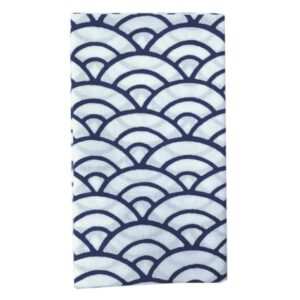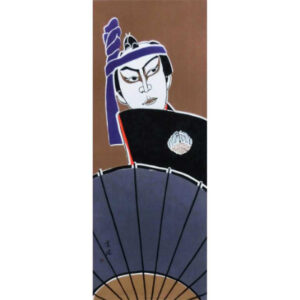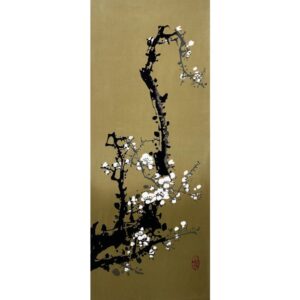説明
手ぬぐい「疋田(山吹・支子)」 江戸小紋
日本の伝統的な絞り染め・疋田(ひった)絞りを手ぬぐいに染め上げました。
鹿の子絞りは、布を糸で小さく絞ってその部分に色染まらないようにした文様で、鹿の斑点に似ていることから名付けられました。振袖など華やかな着物でよく見られ、手間のかかる細かい絞り染めです。鹿の子絞りをより手軽で安価に表現するために、鹿の子そのものを絵柄として表す疋田文様が生まれました。江戸の人々の美意識と創意工夫によります。
支子(くちなし)色とは、赤みがかった黄色で歴史に登場し始めたのは平安時代から。古今和歌集などにも出てきた日本の伝統色です。染料や薬料として用いられ古くから日本人に親しまれてきました。風水では支子を含む黄色は金運アップをもたらし、福を呼ぶ色とされています。
絵柄に込められた縁起の良い意味と共にお正月飾りやお年賀、誕生日プレゼントや出産祝い・初節句祝いなどおめでたい時節のプレゼントにおすすめ。また、日本の伝統工芸品「手拭」は外国の方へのギフトやおみやげにも喜ばれます。
サイズ:90×35cm
綿100% 日本製
Tenugui “Hitta-Kanoko Pattern(Kuchinashi-yellow)”
This is a tenugui with a pattern of Hikita-shibori, one of the traditional Japanese tie-dyeing techniques. “Kanoko-shibori” is a pattern in which the cloth is squeezed into small pieces with thread so that the colors do not bleed into those areas, and is named after its resemblance to the spots of a deer. It is often seen in gorgeous kimonos such as furisode (long-sleeved kimono).In order to express “Kanoko-shibori” more easily and inexpensively, the “Hikita” pattern was created to express the pattern itself as a design. This is due to the aesthetic sense and ingenuity of the people of the Edo period.
“Kuchinashi color” is a reddish yellow color that first appeared in history in the Heian period (794-1185). It is a traditional Japanese color that has been mentioned in the Kokin Waka Shu. It has been used as a dye and medicine, and has been familiar to the Japanese people since ancient times. It can be used not only as a daily tenugui, but also as a neckpiece for the kimono, a scarf, or as a material for handmade goods.
Size:90×35cm
100% Cotton Made in Japan
Related Products

手ぬぐい「縁起・吊り飾り」

手ぬぐい「元禄美人図」

手ぬぐい「紅白梅図」

手ぬぐい「碇・知盛」

手ぬぐい「隈取・暫」

手ぬぐい「式三番叟」

手ぬぐい「大津絵 鬼の念仏(茶)」

手ぬぐい「招き猫とお福さん」

手ぬぐい「桜(ピンク)」

手ぬぐい「ネコたちの夏」

手ぬぐい「亥と富士」
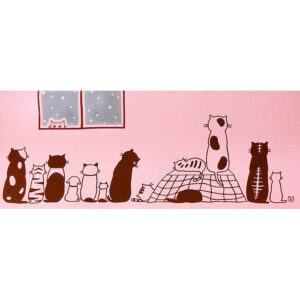
手ぬぐい「ネコたちの冬」
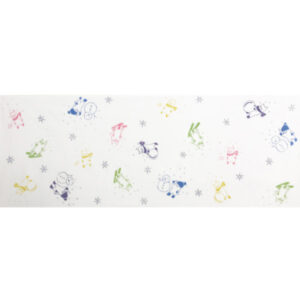
手ぬぐい「エンジョイスノー」
」616-300x300.jpg)
手ぬぐい「唐草(グリーン)」

手ぬぐい「ネコ市松(グレー)」
」-300x300.jpg)
手ぬぐい「纏(青)」

手ぬぐい「歌舞伎衣裳・お坊吉三」

手ぬぐい「うわなり」

手ぬぐい「招き猫(赤)」

手ぬぐい「大津絵 鬼の念仏(ベージュ)」

手ぬぐい「弁天小僧菊之助」

手ぬぐい「麻の葉(赤)」

干支手ぬぐい「雪と兎」

手ぬぐい「ネコたちの春」

手ぬぐい「隈取市松(緑)」

手ぬぐい「絵馬・ひつじ」

扇子袋セット「シャトン」
」-300x300.jpg)
手ぬぐい「纏(紺)」

手ぬぐい「大津絵・釣鐘提灯」

手ぬぐい「かまわぬ」

手ぬぐい「紅葉(グリーン)」

手ぬぐい「大津絵 藤娘」
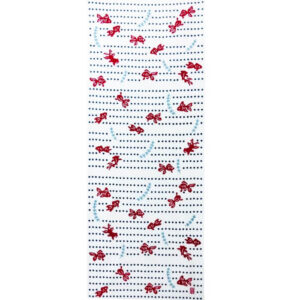
手ぬぐい「豆絞り金魚」

手ぬぐい「夏祭団七九郎兵衛」

手ぬぐい「銀河鉄道」

手ぬぐい「さくらさくら」

手ぬぐい「長春・葡萄鉢」

手ぬぐい「桜(紺)」
」2-300x300.jpg)
手ぬぐい「疋田(赤・紅赤)」

手ぬぐい「板締め豆絞り」

手ぬぐい「唐草(グレー)」

手ぬぐい「隈取市松(柿色)」

手ぬぐい「招き猫(黄)」

手ぬぐい「桜と犬(紺)」

手ぬぐい「麻の葉(灰青)」
」-300x300.jpg)
手ぬぐい「トンボ(紺)」

手ぬぐい「カエルの酒盛り」

手ぬぐい「羊たちのNight&Day」

手ぬぐい「隈取ちらし」
」1-300x300.jpg)
手ぬぐい「疋田(緑・柳染)」

手ぬぐい「ネコ紅葉」

手ぬぐい「そば猪口 (蝶)」

手ぬぐい「お嬢吉三」

手ぬぐい「白浪五人男」

手ぬぐい「歌舞伎衣裳・三千歳(梅)」

手ぬぐい「そば猪口 (紅葉)」

手ぬぐい「菊五郎格子」
」-300x300.jpg)
手ぬぐい「トンボ(青)」
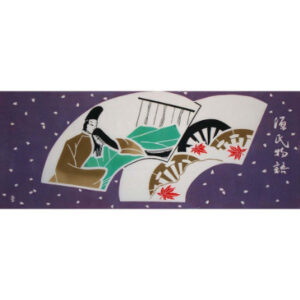
手ぬぐい「源氏物語」

手ぬぐい「外郎売り」

手ぬぐい「風姿花伝」

手ぬぐい「福・椿鉢」

干支手ぬぐい「巳と梅紋」

手ぬぐい扇子「猫の風神雷神(風神)」
-300x300.jpg)
手ぬぐい「桜と犬(茶)」

手ぬぐい「ネコ市松(青)」

手ぬぐい「干支・牛天神」
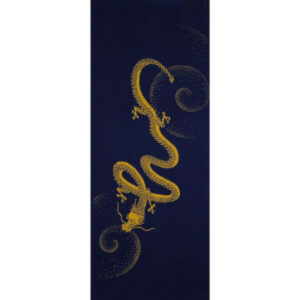
手ぬぐい「干支・龍」



」3.jpg)


」.jpg)



